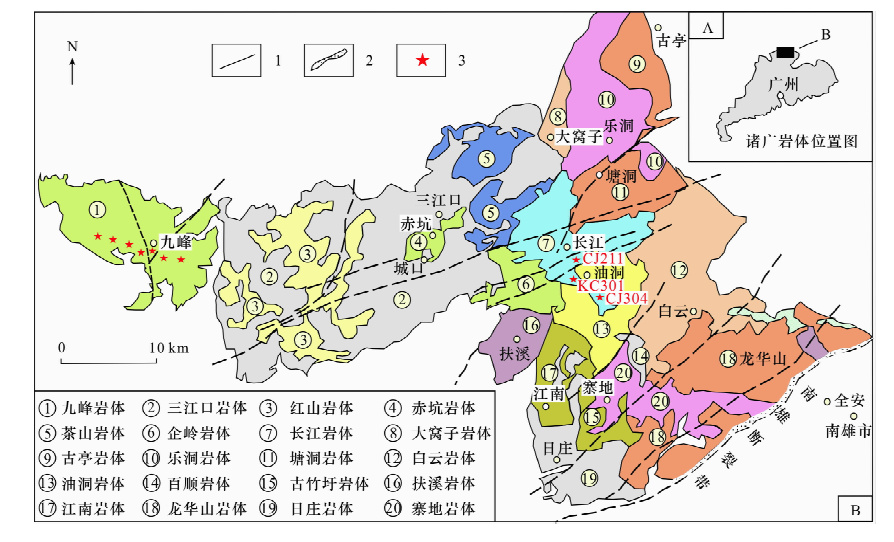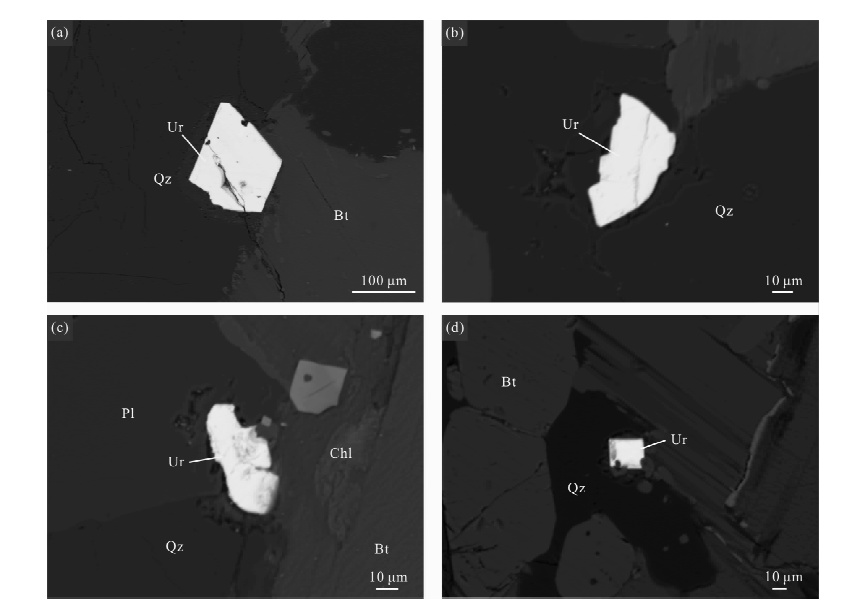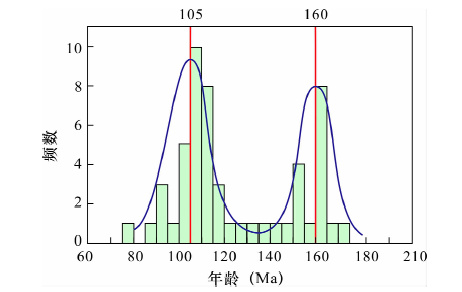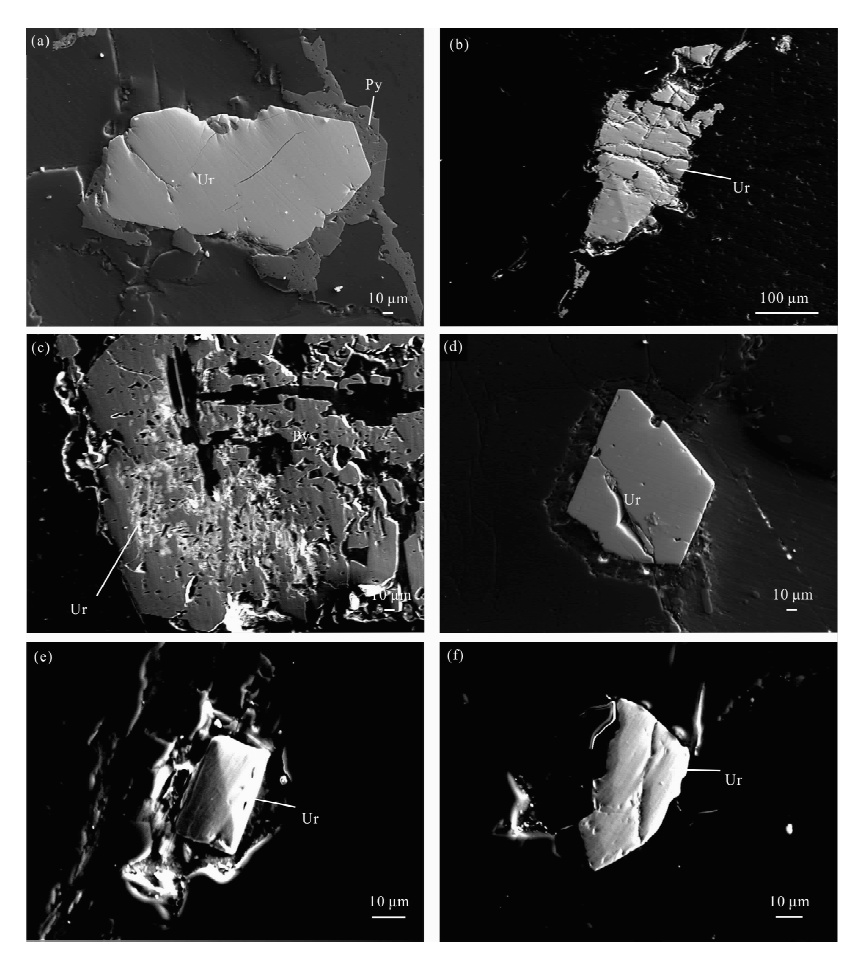EPMA Study on Characteristics of Uranium Minerals in Uranium-bearing and Uranium-barren Granites in Northern Guangdong and Its Prospecting Significance
-
摘要:
晶质铀矿的含量、形貌、成分、铀矿物类型、与铀矿物共存的矿物组合等特征可以作为产铀与不产铀岩体的判别标志,为花岗岩型铀矿找矿工作提供了一种新的技术手段。长江岩体和九峰岩体是粤北地区典型的产铀与不产铀花岗岩体,本文利用电子探针测试了九峰岩体的铀矿物并与长江岩体进行对比研究。结果表明九峰岩体的铀矿物主要为晶质铀矿,其化学年龄可分为两组,分别为~160 Ma、~105 Ma,与长江岩体的两组晶质铀矿年龄基本一致;其中第一组年龄代表岩体的成岩年龄,第二组年龄与粤北地区~105 Ma的基性岩脉侵入时代相对应;但九峰岩体缺少长江岩体中~74 Ma的成矿年龄。相比于长江岩体,九峰岩体的铀矿物受到后期热液事件的影响较小,铀没有发生明显的活化、转移,因而未能富集成矿,没有形成具有工业价值的铀矿床。
Abstract:The content, morphology and composition of uraninite, types of uranium minerals, and mineral assemblages coexisting with uranium minerals can be used as the distinguishing marks of uranium-bearing and uranium-barren granites, which provides a new technique for prospecting granite-hosted deposits. Changjiang and Jiufeng granitic intrusions are typical uranium-bearing and uranium-barren granites in northern Guangdong. Uranium minerals from these two granitic intrusions were studied by Electron Microprobe. Results show that the main uranium mineral of Jiufeng granite is uraninite, and its age dated by Electron Microprobe can be divided into two groups, 160 Ma and 105 Ma, which are consistent with those of uraninite in Changjiang granite. The first group age represents the formation age, and the second group corresponds to the invasion age of mafic dikes at 103 Ma. But the age of 74 Ma was not found for Jiufeng granite. Compared with Changjiang granite, uranium minerals of Jiufeng granite are less affected by the late hydrothermal events and U is not activated and migrated, so that no economic uranium deposits occur in Jiufeng granite.
-
Keywords:
- uranium minerals /
- electron microprobe /
- distinguishing marks /
- Changjiang granite /
- Jiufeng granite
-
煤矸石是煤炭开采、洗选加工过程中排放的固体废物,约占原煤总产量的15%左右,是我国工业固体废物的主要来源之一[1, 2]。排出的煤矸石露天堆存于地表,占用大量土地,在自然风化和淋溶过程中部分微量元素会迁移释放进入环境,极易造成周围土壤和水体的污染。煤矸石中微量元素的总量为评价其环境效应提供了重要的基础信息,但其迁移性和生物可利用性不仅与总量相关,而且在很大程度上取决于活性赋存状态所占的比例,因此研究煤矸石中微量元素的赋存状态非常必要。国内外一些学者研究了煤矸石中微量元素的含量特征及变化范围,遴选出多种高于环境背景值并值得关注的元素,包括Cd、Cu、Hg、Mn、Ni、Sn等[3, 4, 5, 6],但对其赋存状态的研究较少,尤其是对低硫煤矸石(全硫含量低于1%)的研究更是鲜见报道。
由于多种微量元素具有亲硫性,而低硫煤矸石含硫量较低,可能导致一些微量元素的含量和赋存状态不同于中高硫煤矸石。同时中国煤中低硫煤储量巨大,占煤炭总储量的58.7%,伴随低硫煤的开采将排出大量低硫煤矸石,堆积于矿区内,对生态环境产生危害[7, 8]。本文以低硫煤产区淮北临涣矿区的低硫煤矸石样品为研究对象,应用电感耦合等离子体发射光谱法(ICP-OES)测定了10种微量元素(Ba、Cd、Co、Cr、Cu、Mn、Ni、Pb、V、Zn)的含量,采用逐级化学提取法结合相关性分析研究了微量元素的赋存状态,并运用风险评价指数法(RAC)评价了其环境效应,以期为指导低硫煤矸石的堆放管理及其综合利用提供科学依据。
1. 样品采集与分析方法
1.1 样品采集与预处理
淮北矿区位于安徽省北部,是中国华东地区重要的煤炭工业基地,矿区内的低硫煤储量丰富,低硫煤矸石堆存量大、占地面积广。本研究选取淮北临涣矿区内一座大型煤矸石山,共采集7组煤矸石样品,包括:① 采用蛇形采样法沿煤矸石山从顶部到底部采集5组样品,其中1组为煤矸石山底部表层弱风化样品,其余4组样品采样深度为煤矸石表层以下20 cm;② 在堆放年限为5年以上的煤矸石堆表层采集风化煤矸石样品1组;③ 另采集巷道掘进过程中的新鲜煤矸石样品1组。
每组样品由5个子样混合而成,质量约1 kg,采集后使用塑封袋密封保存。采集的样品在室内自然风干,破碎后按四分法取10 g样品,经玛瑙研钵研磨后过100目尼龙筛,保存于棕色试剂瓶中,备用。
1.2 样品分析项目和测定方法
煤矸石样品分析项目包括全硫、灰分、Al、Ca、Fe和10种微量元素(Ba、Cd、Co、Cr、Cu、Mn、Ni、Pb、V、Zn)。其中,样品中全硫的测定采用WS-S101型自动测硫仪(长沙瑞翔科技有限公司),全硫测定结果为0.13%~0.46%,在低硫煤矸石含量范围内。灰分的测定依据国家标准GB/T 212—2008。微量元素赋存状态的研究采用Tessier逐级化学提取法[9],依据不同提取步骤,将其赋存状态分为可交换态、碳酸盐结合态、铁锰氧化物结合态、有机结合态、残渣态。运用XSP IntrepidⅡ型电感耦合等离子体发射光谱仪(美国Thermo公司)测定常量元素Al、Ca、Fe以及微量元素的总量和不同赋存状态下的含量。
各分析项目测试过程中,由空白样、平行样和标准样品(土壤成分分析标准物质GBW07403和国际标准煤样物质SRM1632b)进行质量控制,微量元素不同形态含量通过标准样品的回收率和微量元素的提取率(即5种提取形态下的提取总量与实测总量的比值)两方面进行质量控制,标准样品回收率反映其准确度,微量元素提取率反映其精密度。结果显示,平行样中微量元素的相对标准偏差(RSD)均小于10%,标准样品测定值均达到标准规定的准确度,微量元素的提取率均在80%~120%之间,表明了测试结果准确、可靠。
2. 低硫煤矸石中微量元素含量和赋存状态特征
2.1 微量元素含量特征
为研究低硫煤矸石中微量元素的富集程度,将所采集样品中的微量元素含量与淮北煤、中国煤、黑色页岩和克拉克值进行平行对比,样品中微量元素含量特征列于表 1。
表 1 煤矸石中微量元素的含量与文献数据的对比Table 1. The concentration of trace elements in coal gangue sample and comparison of analytical results with relative references微量
元素本研究的低硫煤矸石样品 淮北煤均值a
(mg/kg)中国煤均值b
(mg/kg)黑色页岩c
(mg/kg)克拉克值d
(mg/kg)富集系数
(EF)含量范围(mg/kg) 平均值(mg/kg) Ba 330.97~439.43 404.54 184.0 243.37 270~800 425.0 0.95 Cd 0.09~0.19 0.14 - 0.24 2~12 0.2 0.69 Co 11.20~32.01 17.34 9.2 7.05 10~30 25.0 0.69 Cr 39.13~53.39 46.60 34.2 15.35 50~160 100.0 0.47 Cu 4.78~13.57 9.34 48.2 18.35 35~150 55.0 0.17 Mn 103.29~373.02 194.64 20.0 125.00 200~800 100.0 1.95 Ni 10.75~35.08 18.18 16.4 13.71 40~140 75.0 0.24 Pb 22.65~38.17 29.61 18.0 15.55 10~40 - - V 108.47~216.20 180.10 108.0 35.05 100~400 135.0 1.33 Zn 26.18~87.63 51.28 304.0 42.18 60~300 70.0 0.73 注:a引自Zheng等[10]、杨萍玥等[11],b引自任德贻等[12],c引自Ketris等[13],d引自Taylor[14];EF为富集系数,即煤矸石中微量元素平均含量与克拉克值之比;“-”表示暂无数据。 表 1中的数据表明,富集系数(EF)最高的两种元素为Mn和V,其EF值分别为1.95、1.33,表明Mn和V相比于地壳背景值在低硫煤矸石中均有较大程度的富集。与淮北煤中微量元素的平均含量相比,Ba、Co、Cr、Mn、Ni、Pb和V在低硫煤矸石中相对富集,其中Mn的富集程度最高,是淮北煤平均值的9.7倍,Ba的含量也较高,是淮北煤均值的2.2倍;而Cd、Cu和Zn在低硫煤矸石中则相对亏损,远低于淮北煤平均值。对比中国煤中微量元素的平均含量,低硫煤矸石样品中除Cd和Cu外,其他元素均呈现相对富集的现象。崔龙鹏等[3]对采集自淮南煤田的44个煤矸石样品中微量元素丰度进行了研究,发现淮南煤田煤矸石中的Mn相对于当地煤的富集程度较大,Cr、Ni和Pb也存在一定程度的富集,可见Mn在煤矸石中的富集现象值得关注。
2.2 微量元素赋存状态特征
微量元素的迁移性和生物可利用性与其赋存状态密切相关,逐级化学提取法可快速、有效地为煤矸石中微量元素赋存状态的研究提供定量依据[15, 16, 17, 18]。相关性分析是间接判定微量元素赋存状态的一种常用方法,它依据微量元素含量与其他成分间的相关系数对微量元素的赋存状态进行判别[19, 20]。微量元素的含量与灰分、Al、Ca、Fe和S含量的相关性分析可以分别表征微量元素与无机矿物质、铝硅酸盐矿物、碳酸盐矿物和硫化物矿物之间的关系,进而判定微量元素在煤矸石中的载体矿物[21, 22, 23]。
逐级化学提取法所得5种相态是微量元素在煤矸石中的化学赋存形态,其每一种赋存形态都需以矿物质这种实体作为载体存在,一种赋存形态可能以多种矿物作为载体,同时一类矿物也可能对应多种赋存形态,例如硫化物矿物对应的赋存状态可为残渣态和铁锰氧化物结合态[19, 22]。图 1为本研究的低硫煤矸石样品中微量元素的逐级化学提取实验结果,表 2列举了微量元素与灰分、Al、Ca、Fe和S之间的皮尔逊(Pearson)相关系数(p < 0.05)。
表 2 煤矸石中微量元素与灰分、Al、Ca、Fe和S之间的Pearson相关系数(p < 0.05)Table 2. The Pearson's correlation coefficients (p < 0.05) of trace elements with Al, Ca, Fe, S and ash yield in coal gangue sample相关系数 r>0.7 0.7>r>0.5 0.5>r>0.35 与灰分 - Ba(0.521)
V(0.594)- 与Al V(0.967) - - 与Ca - - Mn(0.369) 与Fe Cu(0.627), V(0.816) Pb(0.541) Cr(0.481) 与S Cd(0.722), Co(0.703)
Cu(0.864), Ni(0.752)Cr(0.630)
Zn(0.523)Mn(0.397) 元素之间 Co-Ni=0.997,Co-Zn=0.876
Ni-Zn=0.863,Co-Mn=0.803
Mn-Ni=0.794,Cd-Zn=0.722- - 注:“-”表示没有在此相关性范围内的元素。 Ba主要以残渣态和铁锰氧化物结合态存在,两者质量分数之和为80.90%,表明其主要以无机结合态赋存于低硫煤矸石中。Ba与灰分的相关系数r=0.521,也表明Ba主要以无机结合态存在。
Cd的残渣态、铁锰氧化物结合态的质量分数分别为58.24%、26.81%,与S(r=0.722) 和Zn(r=0.722) 有较高的相关系数,表明Cd以黄铁矿、闪锌矿等硫化物矿物为载体赋存于低硫煤矸石中。Finkelman等[24]、王文峰等[25]认为煤中微量元素Cd通常与黄铁矿和闪锌矿中的铁离子、锌离子发生类质同象置换赋存于矿物中。
Co的残渣态、铁锰氧化物结合态的质量分数之和为91.98%,与S的相关系数r=0.703,表明Co在低硫煤矸石中赋存于硫化物矿物中。Zhou等[26]研究了淮南煤矸石中微量元素的赋存状态和环境效应,也发现Co与无机矿物联系紧密并赋存于硫化物矿物中。
Cr的残渣态含量较高(质量分数为89.84%),同时与Fe(r=0.481) 和S(r=0.630) 的相关系数较高,表明Cr赋存于硫化物矿物中。任德贻等[27]对辽宁沈北煤田的煤样中伴生元素的分布特征进行了研究,发现Cr除了与黏土矿物和有机质相关外,更主要与硫化物矿物有关。
Cu的残渣态的质量分数为39.62%,其次为铁锰氧化物结合态、有机结合态(质量分数分别为29.33%、20.87%)。Cu是一种强亲硫元素,与Fe(r=0.627) 和S(r=0.864) 的相关性较高,表明其在低硫煤矸石中赋存于黄铁矿等硫化物矿物中。Ribeiro等[20]研究了葡萄牙西北部Douro煤田煤矸石的岩相学和地球化学特征,也发现Cu主要与硫化物矿物结合,可能存在于黄铁矿和黄铜矿中。
Mn的残渣态含量最高,其次为碳酸盐结合态(质量分数为24.01%),与Ca、S的相关系数分别为r=0.369、r=0.397,表明Mn赋存于碳酸盐矿物、硫化物矿物中。Zhou等[18]研究了淮南煤田煤矸石中微量元素赋存状态和迁移特征,也发现煤矸石中Mn的赋存状态主要是硅酸盐结合态和碳酸盐结合态,此外还有一定量硫化物结合态的Mn存在。
Ni的残渣态、铁锰氧化物结合态的质量分数之和为75.41%,与S的相关系数r=0.752,表明Ni赋存于硫化物矿物中。
Pb的残渣态的质量分数为58.56%,其次为有机结合态、铁锰氧化物结合态(质量分数分别为15.33%、14.14%)。Pb与Fe(r=0.541) 有一定相关性,表明低硫煤矸石中的Pb不仅赋存于硫化物矿物中,而且还与有机质相关。方铅矿(PbS)是其最常见的赋存矿物[25]。
V的残渣态含量较高(质量分数为69.57%),与Al(r=0.967)、Fe(r=0.816)、灰分(r=0.594) 有较好的相关性,表明V主要以无机结合态存在,赋存于铝硅酸盐等黏土矿物中。Ribeiro等[20]和Zhou等[26]分别对葡萄牙西北部Douro煤田煤矸石和淮南煤田煤矸石中微量元素的赋存状态进行研究,也发现煤矸石中V主要赋存于黏土矿物等无机矿物中。
Zn的残渣态、铁锰氧化物结合态质量分数分别为45.74%、27.37%,与S(r=0.523) 有较高的相关系数,与Co(r=0.876) 和Ni(r=0.863) 这两种赋存于硫化物矿物中的元素也有很高的相关性,表明Zn赋存于硫化物矿物中,有强烈的亲硫性。
综合分析以上10种微量元素的赋存状态可知,微量元素具有相似的赋存形态,5种相态中均以残渣态含量最高,表明微量元素有很大一部分比例是以较稳定的形态存在。低硫煤矸石中的微量元素大部分赋存于硫化物矿物中,仅有个别元素(如Mn、V)分别赋存于碳酸盐矿物、黏土矿物中。由此可见,多种微量元素具有亲硫性,而低硫煤矸石的含硫量较低,影响了一些微量元素的赋存状态。
3. 低硫煤矸石中微量元素的环境效应
采用国际沉积物质量指南(SQGs)计算的微量元素对生物造成毒性效应的效应浓度低值(ERL)和效应浓度中值(ERM)对煤矸石中微量元素Cd、Cr、Cu、Ni、Pb和Zn进行评价。ERL是微量元素对沉积物中寄居的生物群极少产生有害效应的浓度值,ERM则是有可能产生有害效应的浓度值[28]。效应范围内的样品数所占的比例可反映微量元素对生物毒性作用的发生率,它被ERL和ERM分为三个区间:样品中微量元素的含量小于ERL、大于ERL且小于ERM、大于ERM。
煤矸石中微量元素在各效应范围的样品数所占比例列于表 3,所有样品中Cd、Cr、Cu、Pb和Zn含量都低于ERL,说明这5种元素基本不会出现生物毒性效应。14%的样品中Ni的含量超过了ERL值,但低于ERM值,产生生物毒性效应可能性极小。100%的样品中微量元素的含量均低于ERM值,表明总体上煤矸石中微量元素对生物造成毒性效应的可能性较小。
表 3 煤矸石中微量元素的环境效应Table 3. The environmental effect of trace elements in coal gangue sample微量元素 ERL~ERM
(mg/kg)各效应范围的样品数(%) 本项研究样品的RAC值 RAC值对应的风险程度a < ERL > ERL且 < ERM > ERM 范围 平均值 RAC值 风险程度 Ba - - - - 7.43~10.04 8.41
< 1
无Cd 1.2~9.6 100 0 0 8.69~14.53 11.7 Co - - - - 1.56~6.04 3.87
1~10
轻度Cr 81~370 100 0 0 3.61~6.40 4.7 Cu 34~270 100 0 0 8.64~12.64 10.19
10~30
中度Mn - - - - 23.87~27.93 26.02 Ni 20.9~51.6 86 14 0 14.43~16.13 15.27
30~50
重度Pb 46.7~218 100 0 0 9.65~16.65 11.97 V - - - - 5.38~10.65 8
>50
极严重Zn 150~410 100 0 0 14.49~17.49 15.76 注:a引自Jain[29]、刘春华等[30];ERL为效应浓度低值,ERM为效应浓度中值,RAC为风险评价指数;“-”表示暂无数据。 微量元素的迁移性和生物可利用性在很大程度上由其活性形态决定,不同赋存状态所产生的环境效应差异很大。风险评价指数法(RAC)是基于形态学研究产生的评价方法,通过分析环境中微量元素的活性形态判定其环境效应。对于Tessier五步提取法取得的微量元素赋存状态,将可交换态和碳酸盐结合态作为活性形态进行评价,活性形态占微量元素总量的比值即为RAC值[29, 30]。低硫煤矸石样品中微量元素的RAC值范围和平均值列于表 3,RAC值对应的风险程度也列于表 3。
通过分析微量元素的RAC值和对应的风险程度,煤矸石中10种微量元素对环境的危害性可排序为:Mn>Zn>Ni>Pb>Cd>Cu>Ba>V>Cr>Co。其中Co、Cr的RAC值最低,仅会引起非常轻度的生态风险;Ba、Cd、Cu、Pb和V产生的生态风险介于轻度和中度之间;Mn、Ni和Zn会造成中度生态风险,其中Mn的RAC值最高(23.87~27.93),表明活性形态的Mn对生态环境造成危害的可能性最大,由Mn可能造成的煤矸石山周边地区土壤及水体污染问题应当引起重视。
4. 结论
通过深入地研究淮北临涣矿区低硫煤矸石中10种微量元素的含量、赋存状态及其环境效应,认为低硫煤矸石中Ba、Co、Cr、Mn、Ni、Pb、V含量均高于淮北煤和中国煤的平均水平,并且Mn、V含量高于克拉克值,其迁移风险值得关注;微量元素主要以残渣态和铁锰氧化物结合态存在,两者质量分数之和为68.87%~92.93%,其中Cd、Co、Cr、Cu、Ni、Pb、Zn赋存于硫化物矿物中,V赋存于黏土矿物中,Mn赋存于碳酸盐矿物和硫化物矿物中;各微量元素的环境危害大小为:Mn>Zn>Ni>Pb>Cd>Cu>Ba>V>Cr>Co,其中Mn的风险评价指数值最高(23.87~27.93),低硫煤矸石在堆存过程中活性态Mn可能造成的污染问题应当引起重视。
本研究一方面对低硫煤矸石中微量元素进行形态分析,确定了其赋存状态;另一方面运用风险评价指数法分析了微量元素的活性形态,评价了其环境效应。研究成果是基于各种微量元素固有的地球化学特性,对研究其他矿区煤矸石中微量元素的赋存特征,指导煤矸石堆放管理、综合利用过程中环境效应评价具有借鉴意义。然而受客观条件的限制,所采集的样品数量、类型不够充足,微量元素赋存状态的研究方法均为间接方法,不能直观地反映出其赋存矿物,对研究结果有一定的影响。基于此,今后应运用直接方法(显微探针技术、谱学分析)和间接方法(化学形态分析、数理统计方法)相结合的手段从多方面深入研究微量元素赋存状态。
致谢: 核工业北京地质研究院葛祥坤博士提供了晶质铀矿的参考样品,并对本文提出了中肯的修改意见,在此表示衷心感谢! -
图 1 诸广山岩体地质简图(据朱捌,2010[13])
1—断裂;2—硅化蚀变碎裂;3—采样位置。
Figure 1. Simplified geological map of Zhuguang mountains(Modified from Zhu,2010)
表 1 九峰岩体铀矿物的电子探针分析结果及化学年龄
Table 1 EPMA data of the main elements in Jiufeng granite and their chemical ages
样品编号 含量(%) 含量(%) 年龄(Ma) UO2 ThO2 PbO SiO2 CaO FeO Y2O3 Ce2O3 Nd2O3 总量 U Th Pb JF-1-1-1 79.43 6.46 1.64 - 0.17 0.08 5.40 0.38 0.30 93.86 70.02 5.68 1.52 159 JF-1-1-2 79.22 4.21 1.04 0.08 0.16 0.38 5.23 0.42 0.29 91.03 69.83 3.70 0.97 103 JF-1-1-3 87.76 2.27 1.01 0.04 - 0.25 1.91 0.49 0.43 94.15 77.36 1.99 0.94 91 JF-1-1-4 81.07 5.48 1.37 - 0.14 0.11 4.84 0.41 0.30 93.72 71.46 4.82 1.27 131 JF-3B-1-1 81.18 7.05 1.73 - 0.12 0.02 4.23 0.56 0.50 95.37 71.56 6.20 1.60 164 JF-3B-1-2 81.37 4.99 1.20 0.03 0.14 - 4.39 0.43 0.30 92.85 71.73 4.39 1.11 115 JF-3B-1-3 81.60 4.88 1.19 0.03 0.08 - 3.92 0.47 0.37 92.55 71.93 4.29 1.11 114 JF-3B-1-4 84.00 4.37 1.09 - 0.08 0.02 3.88 0.35 0.38 94.18 74.05 3.84 1.01 101 JF-3B-1-5 80.65 7.31 1.71 0.07 0.19 0.03 3.74 0.35 0.22 94.28 71.10 6.43 1.58 163 JF-3B-1-6 82.50 4.82 1.19 - 0.06 0.05 4.13 0.26 0.23 93.24 72.73 4.23 1.11 113 JF-3B-1-7 83.83 5.52 1.01 - 0.09 0.01 3.94 0.32 0.37 95.08 73.89 4.85 0.93 93 JF-3B-1-8 80.75 5.89 1.32 0.04 0.17 - 4.25 0.37 0.26 93.04 71.18 5.18 1.23 127 JF-3B-1-9 81.58 4.70 1.13 - 0.12 0.01 4.26 0.35 0.28 92.43 71.92 4.13 1.05 108 JF-3B-1-10 83.89 7.82 1.78 0.02 0.09 0.04 3.88 0.29 0.18 97.98 73.95 6.87 1.65 163 JF-3B-1-11 81.71 4.84 1.11 - 0.09 0.04 3.70 0.37 0.50 92.35 72.02 4.25 1.03 106 JF-3B-1-12 80.68 5.09 1.23 - 0.12 0.01 4.13 0.41 0.44 92.12 71.12 4.47 1.15 119 JF-3B-1-13 81.02 4.66 1.09 - 0.09 - 3.82 0.44 0.40 91.54 71.42 4.10 1.02 105 JF-3B-1-14 81.39 7.11 1.73 - 0.14 - 4.09 0.47 0.54 95.47 71.75 6.25 1.60 164 JF-3B-1-15 82.30 4.67 1.13 - 0.03 0.08 3.58 0.30 0.35 92.44 72.55 4.10 1.05 107 JF-3B-1-16 81.18 7.05 1.73 - 0.12 0.02 4.23 0.56 0.50 95.37 71.56 6.20 1.60 164 JF-3B-1-17 81.37 4.99 1.20 0.03 0.14 - 4.39 0.43 0.30 92.85 71.73 4.39 1.11 115 JF-3B-1-18 80.95 4.73 1.17 - 0.09 0.02 4.31 0.63 0.45 92.34 71.35 4.16 1.08 112 JF-3B-1-19 81.25 4.29 1.03 0.01 0.09 0.04 3.60 0.28 0.31 90.89 71.62 3.77 0.96 99 JF-3B-1-20 81.48 4.28 1.06 - 0.18 0.02 3.53 0.47 0.41 91.42 71.82 3.76 0.98 101 JF-5-1-1 82.67 6.83 1.65 0.01 - 0.26 2.95 0.44 0.40 95.20 72.87 6.00 1.53 154 JF-5-1-2 86.12 4.75 1.18 0.25 0.01 0.50 2.98 0.60 0.52 96.92 75.92 4.18 1.09 107 JF-7B-1-1 79.82 6.63 1.60 0.01 0.07 0.15 5.75 0.25 0.19 94.45 70.36 5.83 1.49 155 JF-7B-1-2 79.42 3.66 1.08 - 0.02 0.12 6.67 0.34 0.24 91.55 70.01 3.22 1.01 107 JF-7B-1-3 80.62 3.83 1.20 0.05 - 0.13 7.44 0.21 0.20 93.67 71.07 3.36 1.11 116 JF-7B-2-1 80.18 4.88 1.09 - - 0.25 5.24 0.30 0.22 92.16 70.68 4.29 1.01 106 JF-7B-2-2 80.40 6.21 1.42 0.03 0.02 0.51 5.45 0.20 0.17 94.41 70.87 5.46 1.32 137 JF-7B-2-3 79.39 4.44 1.13 0.08 0.02 0.33 5.84 0.16 0.10 91.49 69.99 3.91 1.05 111 JF-8-1-1 91.88 4.57 1.93 0.07 - 0.16 1.24 0.14 0.10 100.09 80.99 4.02 1.79 164 JF-8-1-2 90.49 2.49 1.37 0.08 - 0.14 1.53 0.27 0.03 96.40 79.77 2.19 1.28 119 JF-8-1-3 91.13 3.05 1.93 0.48 0.06 0.13 1.59 0.26 0.10 98.73 80.33 2.68 1.79 166 JF-9-1-1 92.28 2.88 1.93 0.54 0.07 0.16 1.48 0.16 0.08 99.58 81.35 2.53 1.79 164 JF-9-1-2 91.36 3.22 1.34 0.09 - 0.24 1.54 0.26 0.17 98.20 80.53 2.83 1.24 114 JF-9-1-3 87.54 4.26 1.62 0.05 0.02 0.25 1.08 0.21 0.06 95.07 77.17 3.74 1.51 144 JF-9-1-4 92.15 4.37 1.81 0.19 0.25 0.34 1.17 0.18 0.08 100.53 81.94 3.84 1.68 152 JF-9-1-5 86.68 2.87 1.11 0.08 0.04 0.20 1.08 0.11 0.02 92.19 76.41 2.52 1.03 101 JF-9-2-1 92.28 1.91 1.49 0.07 - 0.10 1.21 0.22 0.07 97.36 81.34 1.68 1.38 127 JF-9-2-2 91.78 2.30 1.85 0.08 - 0.08 1.20 0.14 0.05 97.48 80.91 2.02 1.71 158 JF-9-2-3 92.47 1.57 1.26 - 0.01 0.07 1.26 0.24 0.07 96.94 81.51 1.38 1.17 107 JF-9-3-1 91.79 2.55 1.22 0.04 - 0.15 1.17 0.13 0.01 97.05 80.91 2.24 1.13 105 JF-9-3-2 93.24 2.61 1.45 0.02 - 0.13 1.25 0.16 0.13 98.98 82.19 2.29 1.34 122 JF-9-3-3 90.58 3.97 1.28 0.03 - 0.21 1.28 0.10 0.12 97.55 79.84 3.49 1.19 110 JF-9-3-4 87.44 3.56 1.67 0.14 - 0.19 1.90 0.38 0.26 95.53 77.08 3.13 1.55 149 JF-9-3-5 88.80 1.81 1.17 0.01 - 0.08 1.44 0.26 0.28 93.84 78.28 1.59 1.09 104 JF-9-3-6 88.53 3.56 1.24 0.10 - 0.17 1.43 0.14 0.08 95.24 78.04 3.13 1.15 109 JF-9-4-1 90.10 4.99 1.74 0.05 - 0.20 1.25 0.26 0.11 98.70 79.42 4.38 1.61 150 JF-9-4-2 85.93 3.56 1.17 0.62 0.12 0.14 1.26 0.15 0.09 93.02 75.74 3.13 1.09 107 JF-9-4-3 89.55 4.70 1.86 - - 0.07 1.48 0.35 0.18 98.19 78.94 4.13 1.73 162 JF-9-5-1 90.96 2.77 1.02 1.93 1.40 1.66 0.95 0.18 - 100.86 JF-9-5-2 80.99 2.20 0.77 3.63 1.74 2.26 0.77 0.07 - 92.44 JF-9-5-3 74.45 1.76 0.61 4.02 2.37 1.49 0.65 0.11 0.03 85.48 JF-9-6-1 73.70 1.42 0.84 12.20 0.29 1.66 1.02 0.05 0.01 91.19 JF-9-6-2 74.55 1.77 0.95 11.55 0.50 1.88 0.94 0.04 0.06 92.23 JF-9-6-3 85.08 1.34 0.89 7.64 1.31 1.14 0.99 0.22 0.07 98.67 -
[1] 杜乐天编著.花岗岩型铀矿文集[M].北京:原子能出版社,1982:1-99. Du L T.On the Granite-type Uranium Deposits[M].Beijing:Atomic Energy Press,1982:1-99.
[2] 张成江.华南几个杂岩体中产铀与非产铀花岗岩的成因及其与铀成矿关系[J].成都理工学院学报,1996,23(4):31-38. Zhang C J.The Genesis of Uranium- and Non-uranium-bearing Granites from Several Complexes South China and Their Relationship to Uranium Mineralization[J].Journal of Chengdu Institute of Technology,1996,23(4):31-38.
[3] 陈佑纬,毕献武,胡瑞忠,等.贵东复式岩体印支期产铀与非产铀花岗岩地球化学特征对比研究[J].矿物岩石,2009,29(3):106-114. Chen Y W,Bi X W,Hu R Z,et al.Comparison of Geochemical Characteristics of Uranium- and Non-uranium-bearing Indosinian Granites in Guidong Composite Pluton[J].Journal of Mineral Petrology,2009,29(3):106-114.
[4] 陈佑纬,毕献武,胡瑞忠,等.贵东岩体黑云母成分特征及其对铀成矿的制约[J].矿物岩石地球化学通报,2010,29(3):355-363. Chen Y W,Bi X W,Hu R Z,et al.The Geochemical Characteristics of Biotites and Their Constrains on Uranium Mineralization in Guidong Pluton[J].Bulletin of Mineralogy,Petrology and Geochemistry,2010,29(3):355-363.
[5] 章健,陈卫锋,陈培荣.华南印支期产铀和非产铀花岗岩黑云母矿物化学成分差异[J].大地构造与成矿学,2011,35(2):270-277. Zhang J,Chen W F,Chen P R.Compositional Differences of the Biotites from the Uranium-forming and Non Uranium-forming Indosinian Granites in South China[J].Geotectonica et Metalbgenia,2011,35(2):270-277.
[6] 陈振宇.黑云母矿物化学能否作为产铀和不产铀岩体的判别标志?[C]//2013年全国岩石学与地球动力学研讨会论文集.北京:中国地质学会,2013. Chen Z Y.Whether the Chemistry of Biotites Can be Used as the Distinguishing Mark of Uranium-bearing and Non-uranium-bearing Granites?[C]//The Proceedings of 2013 Petrology and Geodynamics Symposium.Beijing:Geological Society of China,2013.
[7] 张成江.贵东岩体花岗岩中晶质铀矿的特征及其找矿意义[J].成都地质学院学报,1990,17(3):10-17. Zhang C J.The Features of Uraninite in Guidong Granite Complex and Its Significance to Search for Uranium Deposit[J].Journal of Chengdu College of Geology,1990,17(3):10-17.
[8] 戎嘉树,冯明月,欧振武,等.花岗岩中晶质铀矿及其找矿意义[J].东华理工学院学报(自然科学版),1980(2):173-183. Rong J S,Feng M Y,Ou Z W,et al.Uraninite in Granite and Its Prospecting Significance[J].Journal of East China Institute of Technology (Natural Science Edition),1980(2):173-183.
[9] 张龙,陈振宇,田泽瑾,等.电子探针测年方法应用于粤北长江岩体的铀矿研究[J].岩矿测试,2016,35(1):98-107. Zhang L,Chen Z Y,Tian Z J,et al.The Application of Electron Microprobe Dating Method on Uranium Minerals in Changjiang Granite,Northern Guangdong[J].Rock and Mineral Analysis,2016,35(1):98-107.
[10] 邓平,任纪舜,凌洪飞,等.诸广山南体燕山期花岗岩的锆石SHRIMP U-Pb年龄及其构造意义[J].地质论评,2011,57(6):881-888. Deng P,Ren J S,Ling H F,et al.Yanshanian Granite Batholiths of Southern Zhuguang Mountian:SHRIMP Zircon U-Pb Dating and Tectonic Implications[J].Geological Review,2011,57(6):881-888.
[11] 邓平,任纪舜,凌洪飞,等.诸广山南体印支期花岗岩的SHRIMP锆石U-Pb年龄及其构造意义[J].科学通报,2012,57(14):1231-1241. Deng P,Ren J S,Ling H F,et al.Indosinian Granite Batholiths of Southern Zhuguang Mountian:SHRIMP Zircon U-Pb Dating and Tectonic Implications[J].Chinese Science Bulletin,2012,57(14):1231-1241.
[12] 黄国龙,刘鑫扬,孙立强,等.粤北长江岩体的锆石U-Pb定年、地球化学特征及其成因意义[J].地质学报,2014,88(5):836-849. Huang G L,Liu X Y,Sun L Q,et al.Zircon U-Pb Dating,Geochemical Characteristic and Genesis of the Changjiang Granite in Northern Guangdong[J].Acta Geologica Sinica,2014,88(5):836-849.
[13] 朱捌.地幔流体与铀成矿作用研究[D].成都:成都理工大学,2010. Zhu B.The Study of Mantle Liquid and Uranium Metallogenesis[D].Chengdu:Chengdu University of Technology,2010.
[14] 葛祥坤.电子探针定年技术在铀及含铀矿物测年中的开发与研究[D].北京:核工业北京地质研究院,2013. Ge X K.Research and Development of Electron Microprobe Dating on Uranium Minerals and U-bearing Minerals[D].Beijing:Beijing Research Institute of Uranium Geology,2013.
[15] Bowles J F W.Age Dating of Individual Grains of Uraninite in Rocks from Eletron Microprobe Analyses [J].Chemical Geology,1990,83(1-2):47-53.
[16] Kempe U.Precise Electron Microprobe Age Determina-tion in Altered Uraninite:Consequences on the Intrusion Age and the Metallogenic Significance of Kirchberg Granite (Erzgebirge,Germany)[J].Contributions to Mineralogy and Petrology,2003,145:107-118.
[17] Skacha P,Golias V,Sejkora J,et al.Hydrothermal Uranium-base Metal Mineralization of the Janska Vein,Brezove Hory,Pribram,Czech Republic:Lead Isotopes and Chemical Dating of Uraninite[J].Journal of Geosciences,2009,54(1):1-13.
[18] Votyakov S L,Ivanov K S,Khiller V V,et al.Chemical Microprobe Th-U-Pb Age Dating of Monazite and Uraninite Grains from Granites of the Yamal Crystalline Basement[J].Doklady Earth Sciences,2011,439(2):244-247.
[19] Votyakov S L,Khiller V V,Shchapova Y V,et al.Composition and Chemical Microprobe Dating of U-Th-bearing Minerals.Part 2.Uraninite,Thorite,Thorianite,Coffinite,and Monazite from the Urals and Siberia[J].Geology of Ore Deposits,2013,55(7):515-524.
[20] 韦龙明,王莉,张广辉,等.广东石人嶂钨矿床中的晶质铀矿研究[J].地质学报,2014,88(4):805-813. Wei L M,Wang L,Zhang G H,et al.Study on the Uraninite in Shirenzhang Tungten Deposit,Guangdong Province[J].Acta Geologica Sinica,2014,88(4):805-813.
[21] 赵慧博,刘亚非,阳珊,等.电子探针测年方法应用于晶质铀矿的成因类型探讨[J].岩矿测试,2014,33(1):102-109. Zhao H B,Liu Y F,Yang S,et al.The Application of Electron Microprobe Dating Method on Genetic Type of Uraninite[J].Rock and Mineral Analysis,2014,33(1):102-109.
[22] Luo J C,Hu R Z,Shi S H.Time of Uranium Mineralization and Geological Implications of Shazijiang Granite-hosted Uranium Deposit Guangxi,South China:New Constraint from Chemical U-Pb Age[J].Journal of Earth Science,2015,26(6):911-919.
[23] Ranchin G.Contribution à L’étude De La Repartition De L’uranium L’tat De Traces Dans Les Roches Granitiques Saines Les Uranites à Teneur levée Du Massif De Saint-Sylvestre (Limousin-Massif Central Francais)[J].Science Terre,1968,13:161-205.
[24] Korzer T G, Kyser T K.O,U,and Pb Isotopic and Chemical Variations in Uraninite:Implications for Determining the Temporal and Fluid History of Ancient Terrains[J].American Mineralogist,1993,78:1262-1274.
[25] Janeczek J,Ewing R C.Mechanisms of Lead Release from Uraninite in the Natural Fission Reactions in Gabon[J].Geochimica et Cosmochica Acta,1995,59(10):1917-1931.
[26] Evins L Z,Jensen K A,Ewing R C.Uraninite Recry-stallization and Pb Loss in the Oklo and Bangombeacute Natural Fission Reactors,Gabon[J].Geochimica et Cosmochimica Acta,2005,69(6):1589-1606.
[27] 张昭明.电子探针在测定晶质铀矿年龄中的应用[J].放射性地质,1982(5):408-411. Zhang Z M.The Application of Electron Microprobe on Dating Uraninite[J].Radioactive Geology,1982(5):408-411.
[28] 陈岳龙,杨忠芳,赵志丹编著.同位素地质年代学与地球化学[M].北京:地质出版社,2005. Chen Y L,Yang Z F,Zhao Z D.Isotopic Geochronology and Geochemistry[M].Beijing:Geological Publishing House,2005.
[29] 李献华.万洋山—诸广山花岗岩复式岩基的岩浆活动时代与地壳运动[J].中国科学(化学),1990(7):747-755. Li X H.Magmatic Activity Age and Crustal Movement of Granite Batholith in Wanyangshan[J].Science Sinica Chimica,1990(7):747-755.
[30] 田泽瑾.诸广山产铀与不产铀花岗岩的年代学、地球化学及矿物学特征研究[D].北京:中国地质大学(北京),2014. Tian Z J.Uranium-bearing and Barren Granites from the Zhuguang Mountain:Geochronology,Element Geochemistry,Mineralogy[M].Beijing:China University of Geosciences (Beijing),2014.
[31] 李献华,胡瑞忠,饶冰.粤北白垩纪基性岩脉的年代学和地球化学[J].地球化学,1997,26(2):14-31. Li X H,Hu R Z,Rao B.Geochronology and Geochemistry of Cretaceous Mafic Dikes from Northern Guangdong,SE China[J].Geochimica,1997,26(2):14-31.
[32] 黄国龙,尹征平,凌洪飞,等.粤北302矿床沥青铀矿的形成时代、地球化学特征及其成因研究[J].矿床地质,2010,29(2):352-360. Huang G L,Yin Z P,Ling H F,et al.Formation Age,Geochemical Characteristics and Genesis of Pitchblende from No.302 Uranium Deposit in Northern Guangdong[J].Mineral Deposits,2010,29(2):352-360.
[33] 尹征平,凌洪飞,黄国龙,等.粤北九峰岩体的地球化学特征与成因研究[J].东华理工大学学报(自然科学版),2010,33(1):15-21. Yin Z P,Ling H F,Huang G L,et al.Research on Geochemical Characteristics and Genesis of Jiufeng Rock Mass in Northern Guangdong Province[J].Journal of East China Institute of Technology,2010,33(1):15-21.
-
期刊类型引用(7)
1. 孙红宾,臧慧媛,张欣,朱云,王蕾. 流动注射法测定咸水和半咸水中的硝酸盐氮和亚硝酸盐氮. 岩矿测试. 2023(05): 934-943 .  本站查看
本站查看
2. 李小莉,高新华,王毅民,邓赛文,王祎亚,李松. X射线荧光在地质材料卤族元素分析中的应用评介. 光谱学与光谱分析. 2022(04): 997-1009 .  百度学术
百度学术
3. 闵宁. HR-ICP-MS法测定淮北煤田太灰水中溴和碘. 保山学院学报. 2022(05): 46-50 .  百度学术
百度学术
4. 王毅民,邓赛文,王祎亚,李松. X射线荧光光谱在矿石分析中的应用评介——总论. 冶金分析. 2020(10): 32-49 .  百度学术
百度学术
5. 石华,刘氘,陶丽萍. 容量法测定卤水中氯元素干扰扣除方法. 化学工程师. 2019(10): 38-40 .  百度学术
百度学术
6. 李可及. 熔融制样X射线荧光光谱法测定岩盐中的主量成分. 岩矿测试. 2016(03): 290-294 .  本站查看
本站查看
7. 姜贞贞,刘高令,王祝,李明礼,卓玛曲西,邵蓓,董锐,王伟. 电感耦合等离子体质谱法测定高海拔地区地热水中的微量元素. 岩矿测试. 2016(05): 475-480 .  本站查看
本站查看
其他类型引用(1)



 下载:
下载:





 京公网安备 11010202008159号
京公网安备 11010202008159号